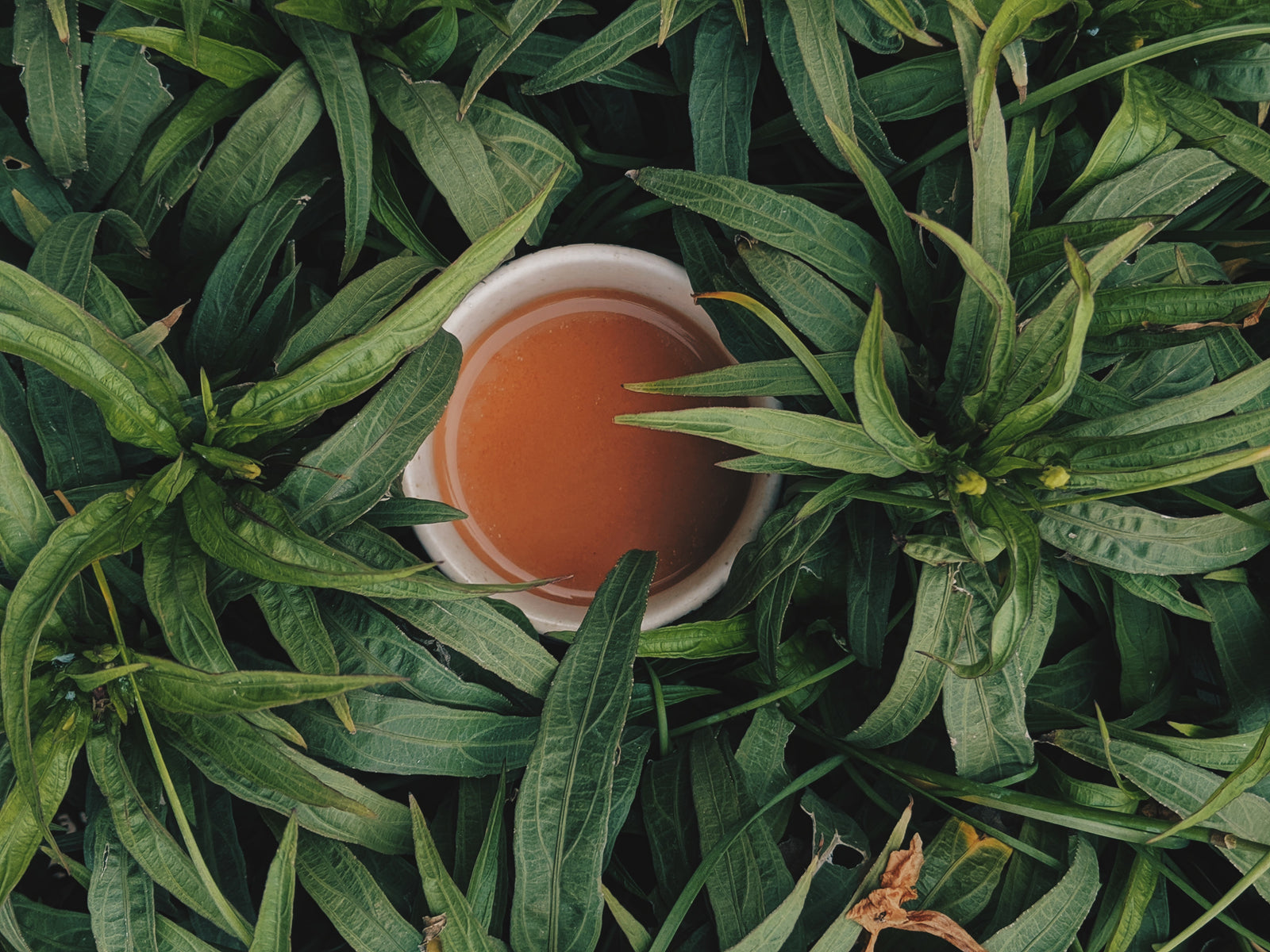What is Jasmine Tea?
During China’s Ming dynasty (1368-1644), jasmine tea started its journey to become the most popular the in the world. The Ming had an obsession with anything floral, and they absolutely loved jasmine flowers. The surviving relics of the time showcase intricate floral patterns and references in everything from porcelain, paintings, embroidery, décor, and literature. Not surprisingly, beautiful blossoms such as chrysanthemum, Osmanthus, orchid and jasmine also made their way into food as well as tea during this period. The tea flavouring trend continued during the following Qing dynasty (1644-1911), in which palate pleasers like bergamot, lychee and orange were added to the scented tea mix.
Yet it was the popular and intoxicating jasmine that became one of the first flavoured teas exported out of China on trade ships headed West during the late 1800s. The world soon fell in love with jasmine’s perfumed aroma and delicate flavour and has been craving the glorious blossom ever since.
What is Jasmine?
The perfumed jasmine flowers that flavour jasmine tea usually come from one of two jasmine species: Common Jasmine (Jasminum officinale) or Sampaguita (Jasminum sambac). Both are related to the olive family, Oleaceae, and produce intensely fragrant and sweet-smelling flowers.
Common Jasmine is so ancient that its exact origins are uncertain. It is said to be native to areas of the Middle East, including Iran, Afghanistan, and Pakistan (where it is the national flower), as well as India, Nepal and certain regions of the Himalayas. Although there are records of Common Jasmine in ancient Chinese texts, it is believed that the plant was imported to China from Persia. Today, the deciduous, vine-like plant is widely cultivated in many temperate areas of the world, including areas of France, Italy, Portugal, Florida, and the West Indies. Common Jasmine’s star-shaped, white flowers blossom to release their powerful scent in summer.
How is Jasmine Tea Made?
Sampaguita’s origins are easier to trace. The species is native to a small region in the eastern Himalayas that straddles Bhutan and neighbouring India, but it grows prolifically and is cultivated across much of Asia and Southeast Asia. It has naturalised in other humid, tropical regions of the world, including Madagascar, Central America, the Caribbean, and Florida. Sampaguita is the national flower of the Philippines. The flowers are strung together into leis, garlands and crowns and used to honour visiting dignitaries, congratulate graduates, celebrate weddings, or mourn deaths. It is also one of three national flowers of Indonesia, where it represents purity and sacredness. Brides and grooms wear garlands of jasmine to represent the flower of life while jasmine flowers are presented as offerings at funerals to honour the spirit of the dead. Sampaguita produces flowers all year long, but its most fragrant flowers bloom during summer.
Like bergamot-infused Earl Grey tea, jasmine tea falls into the industry category of flavoured or scented tea. This includes any type of tea that has been flavoured or scented with flowers, fruit, spices, oils, extracts, and natural or artificial flavours. While jasmine’s fragrant and intoxicating scent is most famously infused into green tea, some tea gardens also produce jasmine tea with a base of white or black tea.
The flowering jasmine plant thrives in similar geographic conditions to China’s most famous teas—in high mountainous elevations ranging from subtropical to cool climates. There are at least seven provinces in China that produce jasmine tea, but the most famous and most traditionally scented jasmine tea comes out of the Fujian region.
A traditionally scented jasmine tea is prized for its sweetness, barely perfumed fragrance, and delicately achieved flavour balance between the floral blossoms and the delicate tea leaves. Great care and skill go into producing a traditional jasmine tea. The process looks something like this:
- Plucking:Tea leaves are plucked in late spring when they are at their freshest and most delicate.
- Drying:Tea leaves are prepared for scenting by either steaming the leaf or drying it with indirect, warm air. Both drying processes apply gentle heat to stop the leaf’s oxidation; this process helps the leaf curl and roll less so there is more surface area for the leaf to absorb the fragrance of the jasmine blossoms once the scenting process begins.
- Storing:Once base tea leaves are prepared, they're kept in cool storage until late summer when the jasmine blossoms are at their peak and ready to be harvested.
- Picking:Jasmine flowers are picked during the hottest time of the summer and at mid-day, when the blossoms are tightly closed against the sun. As they dry and cool, the blossoms burst open and are at their prime for the scenting process.
- Scenting:The harvested and just-bloomed jasmine flowers are mixed with the awaiting tea leaves in rooms (or machines) with carefully controlled temperature and humidity. Tea leaves are naturally highly absorbent and therefore make the perfect base to accept the fragrant scent of the jasmine flower simply by coming into close contact with the blossom. Depending on the grade of tea and style of the tea master, the tea base may be scented multiple times. For each round of scenting, a fresh batch of jasmine blossoms may be introduced to the tea base to add another layer of floral flavours. This process could take anywhere from 24 hours to several weeks depending on the intended result.
- Firing:The final mix of scented tea is then fired to completely dry both the tea leaves and jasmine blossoms, so all moisture is removed. Sometimes the spent blossoms may be left in the tea blend; although this would be for appearance only since all of the fragrance would have transferred from the blossoms to the tea leaves during the scenting process.
While this traditional way of scenting jasmine tea is the most natural, it is also the most laborious. To keep up with demand for the perfumed delicacy the world has come to love, the tea industry has developed more competitive ways to infuse the coveted jasmine flavours into tea. Commercially scented jasmine teas may be flavoured with jasmine oil or natural jasmine flavours. These commercially scented teas are flavoured immediately during the tea production process, without having to rely on weather patterns, harvest schedules, and storage processes.
Tasting jasmine tea
How a jasmine tea tastes can depend on many factors, including what tea base is used (green, white or black), where both the tea leaves and jasmine blossoms were grown, what kind of process was used to scent the tea (traditional or commercial), and how the final cup of tea was brewed. Yet there are some common traits used to describe the overall flavours profile of jasmine tea, including: floral, sweet, perfumed, fresh, blossomed, dewy, bouquet, fragrant, delicate, and subtle. We recommend our Tea Makers Of London Jasmine Tea Loose Leaf
Caffeine content in jasmine tea
All jasmine teas contain caffeine since they are made from a base of naturally caffeinated Camellia sinensis tea leaves. To gauge the caffeine level in jasmine tea, consider the base tea the jasmine was made with. Jasmine is most made with a green tea base, but some manufacturers offer jasmine flavoured white and black teas as well.
Generally, a green tea is known to have lower caffeine content per cup than black tea yet slightly higher caffeine content than white tea. Like all drinks cultivated from caffeinated plants, the level of caffeine per cup can range depending on the type of tea as well as how is was processed and prepared. So if you’re watching your caffeine intake, be sure and read the packaging carefully or ask your tea supplier directly for the caffeine information specific to the tea you are buying.
Buying and storing jasmine tea
Some people claim they don’t like jasmine tea because they don’t like how it tastes; most likely they have sipped a poorly brewed, low quality or even stale jasmine tea. To ensure you’re getting a jasmine tea worth sipping, buy tea from a reputable company that can tell you when and how the tea was processed and packaged. What region did the tea come from? When was it harvested and how was it scented with jasmine blossoms? How long should you expect it to last in your tea cupboard? Also, ask your tea purveyor for directions on how to brew the best cup of that variety of jasmine tea.
While tea can get stale, it won’t ever really go “bad”. Jasmine white and green teas are less oxidized than their jasmine black tea cousin. Therefore, white and green jasmine teas are technically fresher and more delicate and should be consumed more quickly for maximum flavours. Jasmine white or green teas are typically best consumed within six months to a year of purchase. A jasmine black tea may stay fresh a year or longer. Tea will stay fresher longer if you store it in a cool, dark place, away from light, oxygen, moisture and fragrant pantry companions like coffee or spices. Check out our storage canisters here
Preparing jasmine tea
Ask your tea supplier for brewing tips if the jasmine tea package does not have specific instructions. Each variety and type of jasmine tea may have different brewing temperatures and steeping time instructions. Here are a few general jasmine green tea brewing tips to get you started:
- Use fresh, pure, cold filtered water.
- Typically, jasmine green teas are brewed at around 82 degrees C. If the water is too hot, especially for green tea, your tea will release more bitterness and astringency more quickly.
- If you don’t have an electric kettle with temperature control, simply allow your boiling water to rest a minute before pouring it over your jasmine green tea leaves.
- If your tea package has specific recommendations for steeping, use those, but using about 2 grams of loose-leaf tea per 8 oz. cup of water is a safe bet.
- Cover your steeping tea to keep all the heat in the steeping vessel.
- Jasmine green tea can steep anywhere from 30 seconds to 3 minutes depending on how the tea was processed. We steep our jasmine tea for 2 to 3 minutes.
- Many high-quality, loose leaf jasmine teas can be steeped multiple times, although you’ll lose more of the jasmine flavour with each steeping.
- Keep in mind that jasmine green tea is generally quite light and subtle, so you may cover up the intended flavour with the addition of milk and/or sugar.
Sources:
Jasmine Tea via Wikipedia
Jasmine via Wikipedia
The Story of Tea: A Cultural History and Drinking Guide by Mary Louw Heiss and Robert J. Heiss, 2007
New Tea Lover’s Treasury by James Norwood Pratt, 1999

